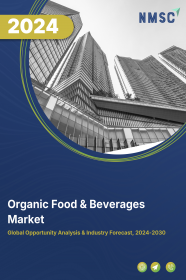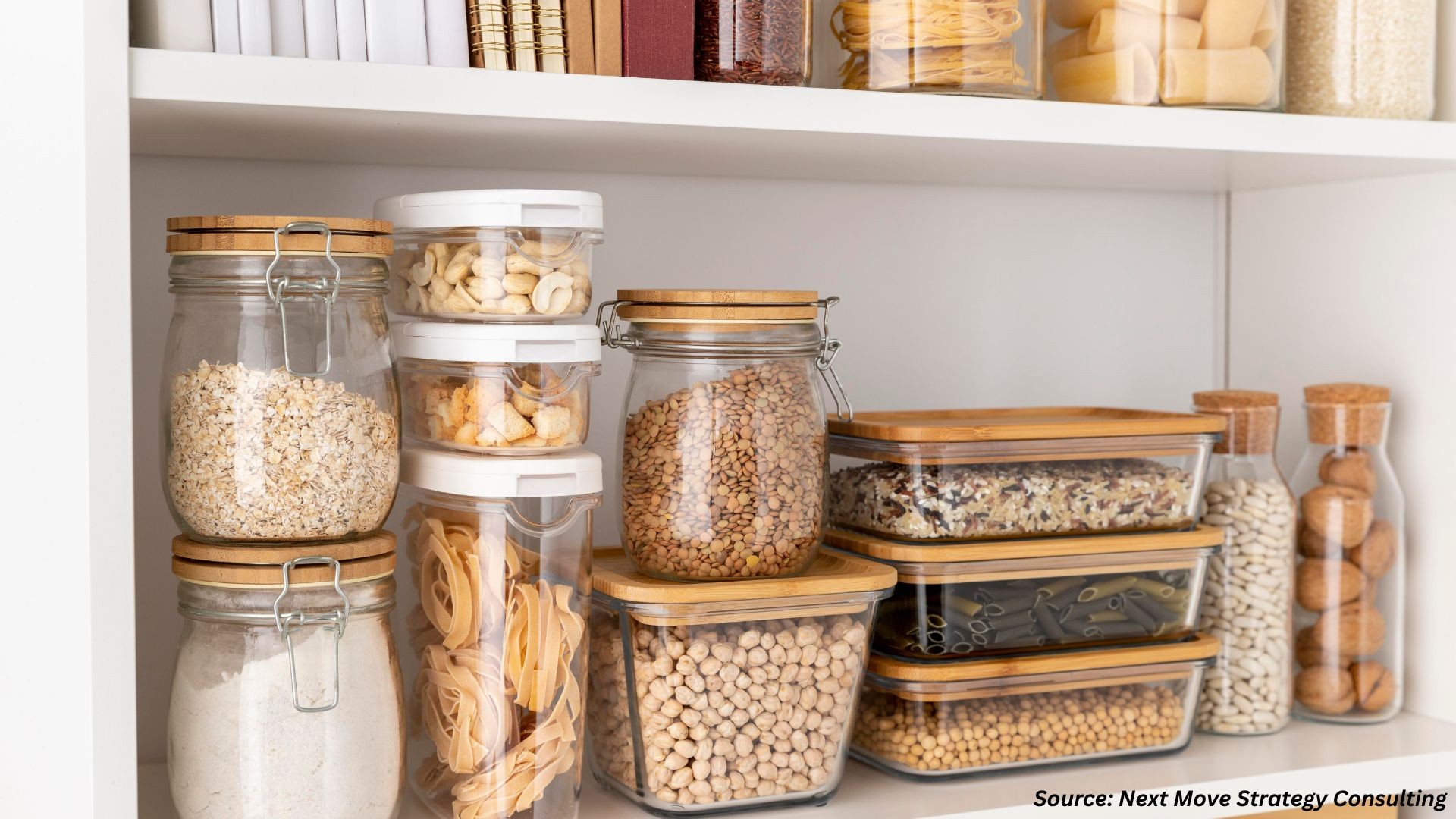
Organic Food and Beverage Market by Product Type (Organic Food (Fruits & Vegetables, Meat, Fish & Poultry, and Others), Organic Beverages (Non-dairy Beverages, and Others)), by Process (Processed and Unprocessed), by Distribution Channels (Online, and Offline (Supermarket/Hypermarket, Convenience Stores, Specialist Stores)), and by End Users (Households, Commercial, Food Service, and Health and Wellness Centers) – Global Opportunity Analysis and Industry Forecast, 2025-2030
Organic Food and Beverage Market Overview
The global Organic Food and Beverage Market size was valued at USD 206.43 billion in 2024 and is predicted to reach USD 230.45 billion by the end of 2025. The industry is predicted to reach USD 399.79 billion by 2030 with a CAGR of 11.6% from 2025-2030.
The organic food and beverage market is growing due to increasing consumer demand for natural, healthier, and environmentally friendly products. Consumers are becoming more health-conscious and prefer organic options that are free from synthetic pesticides and GMOs. Rising environmental awareness also drives the market as more people support sustainable farming practices.
However, higher costs of organic products, due to labour-intensive farming and certification, present a barrier for price-sensitive consumers. Despite this, there are significant opportunities in product innovation, as consumers seek a wider variety of organic options beyond basic produce.
The Heightened Consumer Emphasis on Natural and Organic Formulations Boosts Market Growth
A significant driver of the industry is the increasing consumer preference for products made with natural and organic ingredients. Consumers are becoming more conscious of the ingredients in their daily consumables and are questioning the potential health and environmental impacts of synthetic substances.
According to the Environmental Working Group, an individual uses multiple products daily that contain a high number of unique chemical ingredients, encouraging a shift toward safer, cleaner alternatives. This awareness is contributing to a growing interest in organic food and drinks perceived as more transparent and freer from harmful additives.
Moreover, the increasing trend regarding "sustainable skincare," reflect a broader inclination toward organic and eco-conscious living. Retailers and brands are responding with offerings that align with these values, reinforcing the shift toward organic choices. This evolving consumer mindset significantly influences the growth trajectory of the organic food and drinks industry.
The Growing Consumer Focus on Health and Wellness Accelerates the Market Growth
One of the primary drivers propelling the organic food and beverage market growth is the increasing consumer focus on health and wellness. People are becoming more conscious about the food they consume and its impact on their bodies. This heightened awareness translates into a greater demand for organic options, which are often perceived as healthier due to the absence of synthetic pesticides, herbicides, and genetically modified organisms (GMOs).
For example, consumers are increasingly choosing organic milk over conventional milk, believing it offers superior nutritional benefits and is produced with higher animal welfare standards. This trend is evident in the thriving organic dairy food and drinks market.
Rising Environmental Consciousness Fuels the Organic Food and Beverage Market Growth
A significant driver for the organic food and beverage market is the growing understanding of the environmental benefits associated with organic farming practices. Consumers are increasingly concerned about the impact of conventional agriculture on the planet, including soil degradation, water pollution, and biodiversity loss. Organic farming, with its emphasis on sustainable practices, such as crop rotation and natural pest control, is seen as a more environmentally friendly alternative. This environmental consciousness contributes significantly to the market size and growth potential of the organic sector.
Cost Barriers Hinders the Widespread Adoption of the Market
A key restraint or challenge facing the organic food and beverage market expansion is the higher price point of organic products compared to their conventional counterparts. The cost of organic farming is higher due to factors such as lower yields in the initial transition period, more labor-intensive practices, and the expenses associated with certification. This price premium deters price-sensitive consumers, limiting the overall market share and accessibility of organic foods and drinks.
Introduction of Plant Based Organic Products Creates Market Opportunities
A significant opportunity for players in the industry lies in product innovation and diversification. As consumer tastes evolve, there is a growing demand for new and exciting organic options beyond basic produce and milk. This includes the development of innovative plant-based alternatives, such as unsweetened options, as well as organic versions of popular convenience foods and beverages.
For instance, Danone introduced unsweetened Silk Nextmilk in 2024, a plant-based organic dairy alternative with cleaner ingredients, highlighting the shift towards healthier, more sustainable choices. Brands that successfully tap into these evolving consumer preferences with high-quality organic products stand to gain a competitive edge and expand their market share in the burgeoning organic market.
Market Segmentations and Scope of the Study
The organic food and beverage market report is segmented on the basis of product type, ingredient type, distribution channels, end users, and region. On the basis of product type, the market is divided into organic food and organic beverages. Organic food is further segmented into fruits & vegetables, meat, fish & poultry, dairy products, frozen & processed food, and others. Organic beverages are divided into non-dairy beverages, coffee & tea, beer & wine, and others. On the basis of ingredient type, the market is classified into plant-based, animal-based, and mineral-based ingredients. On the basis of distribution channels, the market is segmented into online and offline. Offline is further segmented into supermarkets/hypermarkets, convenience stores, and specialist stores. On the basis of end users, the market is segmented into households, commercial, food service, and health and wellness centers. Regional breakdown and analysis of each of the aforesaid segments include regions comprising North America, Europe, Asia-Pacific, and RoW.
Geographical Analysis
North America is a major player in the industry growth, driven by a mature consumer base and established market players. The growing emphasis on health and wellness, coupled with strong consumer preference for organic products, particularly dairy, has fueled demand across the region. Government data from the U.S. Department of Agriculture (USDA) highlights that organic food sales have been consistently rising, with more consumers prioritizing products free from synthetic pesticides and GMOs. This trend aligns with the U.S. government's ongoing investments in organic farming programs, further supporting market expansion. Key players, such as Danone and General Mills, are expanding their organic product portfolios to meet consumer demand, solidifying North America's dominance in the sector.
In Europe, the market is well-established, particularly in countries like Germany, the UK, and the Netherlands. The UK, for instance, experienced its highest growth in organic food sales in 15 years, as reported by the Soil Association. This growth is driven by rising consumer awareness of the environmental and health benefits of organic products.
However, some regions, such as France, have seen a slight decrease in organic farmland in recent years, potentially indicating a shift in consumer habits or challenges in organic farming adoption. The EU has set ambitious goals for increasing organic farmland as part of its Green Deal, ensuring continued support for the industry’s growth in the region.
The Asia-Pacific region, particularly India, holds substantial growth potential in the organic food and beverage sector, though it faces challenges such as price sensitivity and limited consumer awareness.
According to government reports from the Indian Ministry of Agriculture, the country is making strides toward promoting organic farming through subsidies and awareness campaigns. India’s rapidly growing middle class and increasing focus on health and sustainability are expected to drive the demand for organic products.
However, the higher cost of organic food remains a barrier for many consumers, limiting broader adoption. Despite this, the government’s efforts to promote organic farming and raise awareness present significant opportunities for organic market players in the region.
The Rest of the World encompasses diverse markets with varying levels of adoption of organic food and beverages. Regions like Latin America and the Middle East are witnessing growing interest in organic products, driven by increasing awareness of the health and environmental benefits associated with organic farming.
However, local economic conditions, consumer education, and affordability challenges affect the pace of growth in these regions. Governments in some countries are implementing policies to support organic farming and sustainable agricultural practices, contributing to the slow but steady rise of organic products in these markets.
Strategic Innovations Adopted by Key Players
Key players in the organic food and beverage industry are actively employing various strategies to capitalize on the increasing consumer demand. A prominent trend is product innovation and diversification, with companies like Rude Health launching a category first clean deck iced coffee range in 2024, featuring organic, additive-free formulations, and MALK Organics introducing new unsweetened plant-based milk options, including Unsweetened Organic Coconut and Unsweetened Organic Soy in March 2025, each made with minimal ingredients to cater to clean-label preferences.
Additionally, in January 2025, Suja Organic launched a line of Organic Protein Shakes with 16 grams of plant-based protein, available in chocolate, coffee bean, and vanilla cinnamon flavors, targeting the ready-to-drink protein market. Some players are focusing on sustainable and ethical sourcing, exemplified by brands emphasizing pure, untouched, organic milk from cows raised with care and highlighting their commitment to farmer-owned models.
However, these players face challenges such as the higher costs associated with organic production, with the U.S. Department of Agriculture noting that organic farming costs is 20-50% higher than conventional methods, and complexities in managing the supply chain to ensure the integrity of organic certification, as enforced by the European Commission’s organic regulations.
Despite these hurdles, significant opportunities exist in catering to health-conscious consumers, with the World Health Organization reporting a 30% rise in demand for organic products among health-focused demographics, and expanding the market share through novel product offerings in the growing organic sector, evidenced by the impressive growth potential predicted for the organic dairy food and drinks market. The market size continues to expand as consumers prioritize organic options, supported by the U.S. Environmental Protection Agency’s emphasis on sustainable consumption and the European Union’s Organic Action Plan promoting organic farming.
Key Benefits
-
The report provides quantitative analysis and estimations of the organic food and beverage market from 2025 to 2030, which assists in identifying the prevailing market opportunities.
-
The study comprises a deep dive analysis of the current and future organic food and beverage market trends to depict prevalent investment pockets in the market.
-
Information related to key drivers, restraints, and opportunities and their impact on the organic food and beverage market is provided in the report.
-
Competitive analysis of the players, along with their market share is provided in the report.
-
SWOT analysis and Porters Five Forces model is elaborated in the study.
-
Value chain analysis in the market study provides a clear picture of roles of stakeholders.
Organic Food and Beverage Market Key Segments
By Product
-
Organic Food
-
Fruits & Vegetables
-
Meat, Fish & Poultry
-
Dairy Products
-
Frozen & Processed Food
-
Others
-
-
Organic Beverages
-
Non-dairy Beverages
-
Coffee & Tea
-
Beer & Wine
-
Others
-
By Process
-
Processed
-
Unprocessed
By Distribution Channel
-
Online
-
Offline
-
Supermarket/Hypermarket
-
Convenience Stores
-
Specialist Stores
-
By End Users
-
Households
-
Commercial
-
Food Service
-
Health and Wellness Centers
By Region
-
North America
-
The U.S.
-
Canada
-
Mexico
-
-
Europe
-
The UK
-
Germany
-
France
-
Italy
-
Spain
-
Denmark
-
Netherlands
-
Finland
-
Sweden
-
Norway
-
Russia
-
Rest of Europe
-
-
Asia Pacific
-
China
-
Japan
-
India
-
South Korea
-
Australia
-
Indonesia
-
Singapore
-
Taiwan
-
Thailand
-
Rest of Asia Pacific
-
-
RoW
-
Latin America
-
Middle East
-
Africa
-
Key Players
-
Brown Living
-
WhiteWave Foods Co
-
General Mills Inc.
-
The Kroger Co.
-
Dean Foods
-
Hain Celestial Group, Inc.
-
Nature Bio-Foods Ltd.
-
Jaivik Bharat
-
Dole Food Company, Inc
-
The Hershey Company
-
Organic Valley
-
Nestlé
-
Conagra Brands, Inc
-
Eden Foods
-
Sunopta
REPORT SCOPE AND SEGMENTATION:
|
Parameters |
Details |
|
Market Size in 2024 |
USD 206.43 Billion |
|
Revenue Forecast in 2030 |
USD 399.79 Billion |
|
Growth Rate |
CAGR of 11.6% from 2025 to 2030 |
|
Analysis Period |
2024–2030 |
|
Base Year Considered |
2024 |
|
Forecast Period |
2025–2030 |
|
Market Size Estimation |
Billion (USD) |
|
Growth Factors |
|
|
Countries Covered |
28 |
|
Companies Profiled |
15 |
|
Market Share |
Available for 10 companies |
|
Customization Scope |
Free customization (equivalent up to 80 working hours of analysts) after purchase. Addition or alteration to country, regional, and segment scope. |
|
Pricing and Purchase Options |
Avail customized purchase options to meet your exact research needs. |




















 Speak to Our Analyst
Speak to Our Analyst

























